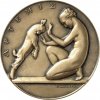ARTEMIS - Bitch or Goddess









Insulting a woman by calling her a female dog pre-dates the existence of the word bitch itself. The English language historian Geoffrey Hughes suggests the connection came about because of the Greek goddess of the hunt, Artemis (Diana in the Roman pantheon) who was often portrayed with a pack of hunting dogs and sometimes transformed into an animal herself. In Ancient Greece and Rome the comparison was a sexist slur equating women to dogs in heat, sexually depraved beasts who grovel and beg for men.
The modern word bitch comes from the Old English bicce, which probably developed from the Norse bikkje, all meaning ‘female dog’. Its use as an insult was propagated into Old English by the Christian rulers of the Dark Age to suppress the idea of femininity as sacred.
Artemis (Ancient Greek: Ἄρτεμις) was one of the most widely venerated of the Ancient Greek deities. Her Roman equivalent is Diana. Some scholars believe that the name, and indeed the goddess herself, was originally pre-Greek. Homer refers to her as Artemis Agrotera, Potnia Theron: "Artemis of the wildland, Mistress of Animals". The Arcadians believed she was the daughter of Demeter.
The childhood of Artemis is not fully related in any surviving myth. The Iliad reduced the figure of the dread goddess to that of a girl, who, having been thrashed by Hera, climbs weeping into the lap of Zeus. A poem of Callimachus to the goddess "who amuses herself on mountains with archery" imagines some charming vignettes: according to Callimachus, Artemis, at three years old, while sitting on the knee of her father, Zeus, asked him to grant her six wishes: to remain always a virgin; to have many names to set her apart from her brother Apollo; to be the Phaesporia or Light Bringer; to have a bow and arrow and a knee-length tunic so that she could hunt; to have sixty "daughters of Okeanos", all nine years of age, to be her choir; and for twenty Amnisides Nymphs as handmaidens to watch her dogs and bow while she rested. She wished for no city dedicated to her, but to rule the mountains, and for the ability to help women in the pains of childbirth.
Artemis' chief "occupation" was to roam the wilderness with her nymphs in attendance hunting for lions, panthers, hinds, and stags. She also saw to their well-being, safety, and reproduction. Because she was a virgin, she demanded that all of her followers devote themselves to purity. According to one story, when the young nymph Callisto was seduced by Zeus and became pregnant, Artemis was so enraged that she changed her into a bear and then killed her. Another story tells of the fate of Actaeon, a mortal hunter who accidentally came across Artemis and her nymphs bathing naked. When Artemis saw him looking, she turned him into a stag and then turned his own dogs against him.

Although she was worshipped as a protector of all young living things, Artemis could be cruel and destructive, and was often blamed for sudden deaths, especially of infants. When Apollo overheard Queen Niobe of Thebes, a mortal, boasting that she had given birth to more children than Leto, he informed his sister. The enraged twins then methodically hunted down and killed all of Niobe's children.
In the following you will find some of my favorite artworks ...



































































